

Mindboggling Consequences In Wake Of Battery Price Drops. Cars Published on December 27th, 2013 | by Guest Contributor Originally published by ABB-Conversationsby Hans Streng We are now in a transition period where battery prices are dropping by 20-30% each year.

Holistic cell design leads to high-performance, long cycle-life lithium-sulfur battery. Researchers at the U.S.
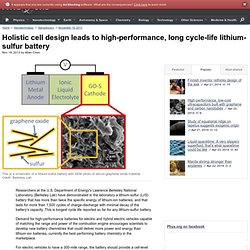
Department of Energy's Lawrence Berkeley National Laboratory (Berkeley Lab) have demonstrated in the laboratory a lithium-sulfur (Li/S) battery that has more than twice the specific energy of lithium-ion batteries, and that lasts for more than 1,500 cycles of charge-discharge with minimal decay of the battery's capacity. This is longest cycle life reported so far for any lithium-sulfur battery.
Plan to heat Manchester homes with geothermal spring approved. 24 October 2013Last updated at 12:23 ET A similar geothermal project is under way in Newcastle Boreholes up to two miles (3.2km) deep will be drilled in Manchester to use a thermal spring to heat homes.

Proposals by GT Energy for the exploratory drilling in the Ardwick area have been approved by the council. If the two boreholes are successful, further plans will be submitted to create a network of underground pipes taking heat to houses. MIT's New Battery-Free Chip Captures Energy From Light, Heat And Vibrations at the Same Time. MIT scientists have developed a new electronic chip that could mark a critical first step towards battery-free systems.
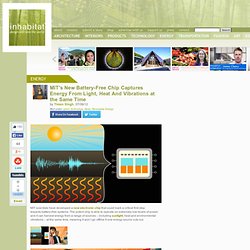
The potent chip is able to operate on extremely low levels of power, and it can harvest energy from a range of sources – including sunlight, heat and environmental vibrations – at the same time, meaning it won’t go offline if one energy source cuts out. The team developing the new chip is led by MIT professor Anantha Chandrakasan. He describes the new energy-combining chip in the IEEE Journal of Solid-State Circuits, stating that the team’s goal is to create a chip that achieves efficient use of multiple power sources in a single device.
By doing so, it would not be reliant on any one source. “Energy harvesting is becoming a reality,” says Chandrakasan, the Keithley Professor of Electrical Engineering and head of MIT’s Department of Electrical Engineering and Computer Science. MIT's Tiny Kinetic Generator Produces 100 Times More Power from Small Vibrations. The labs at MIT are shaking things up – literally – as they just unveiled a tiny device that harvests energy from everyday, low-frequency vibrations.

The breakthrough gizmo generates 100 times more power than other devices like it, and it can harvest electricity from a wide range of sources including footsteps, auto traffic, and even swaying bridges. Aimed primarily at supporting wireless sensor networks, the device could be used to create an ambient energy harvesting system right under our feet. Scientists have been using wireless sensor networks to measure and monitor the environmental conditions of just about everything these days.
They can track pollution, measure bridge and building movement, monitor oil pipelines, and even help predict the temperature changes in forests before a mass fire. Though technological improvements have decreased the energy use of wireless sensor networks, their batteries still need to be changed periodically. Analyst: PV to provide 2% of global electricity supply by 2018. With high-profile bankruptcies, shrinking subsidies and a multilateral trade dispute, now might not seem to be the best of times for the photovoltaics (PV) industry.

But analysts at Lux Research are urging those still active in the PV sector to act now in order to ensure that they can benefit from an installations market that they expect to grow at a compound rate of more than 10% over the next five years. Matt Feinstein and Ed Cahill calculate that, in 2018, some 61 GW of PV capacity (at peak output) will be plugged into electricity grids around the world. Homegrown Green Energy Is Making Power Utilities Irrelevant.
There are 3,200 utilities that make up the U.S. electrical grid, the largest machine in the world.
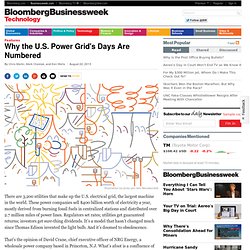
These power companies sell $400 billion worth of electricity a year, mostly derived from burning fossil fuels in centralized stations and distributed over 2.7 million miles of power lines. Regulators set rates; utilities get guaranteed returns; investors get sure-thing dividends. It’s a model that hasn’t changed much since Thomas Edison invented the light bulb. To build world’s largest nationwide network of EV fast-charging stations in the Netherlands. ABB wins contract for nationwide electric vehicle fast-charging infrastructure in the Netherlands bringing a charging station within 50 kilometers of all 16.7 million inhabitants Zurich, Switzerland, July 8, 2013 – ABB, the leading power and automation technology group, announced today that it has been selected by Fastned to supply chargers to more than 200 electric vehicle fast-charging stations in the Netherlands, bringing an EV fast charger within 50 kilometers of all of the country’s 16.7 million inhabitants.
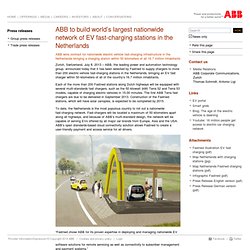
Each of the more than 200 Fastned stations along Dutch highways will be equipped with several multi-standards fast chargers, such as the 50 kilowatt (kW) Terra 52 and Terra 53 models, capable of charging electric vehicles in 15-30 minutes. The era of energy dinosaurs is coming to an end. Working in clean energy can be frustrating.
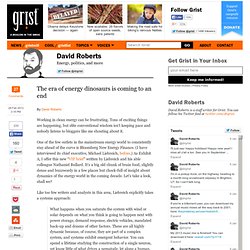
Tons of exciting things are happening, but elite conventional wisdom isn’t keeping pace and nobody listens to bloggers like me shouting about it. One of the few outlets in the mainstream energy world to consistently stay ahead of the curve is Bloomberg New Energy Finance. (I have interviewed its chief executive, Michael Liebreich, before.) As Exhibit A, I offer this new “VIP brief” written by Liebreich and his able colleague Nathaniel Bullard. Scientists develop solar PV fabric using energy generating thread > Data > Research. By ClickGreen staff.

Published Thu 06 Dec 2012 14:46 Solar fibre can be weaved like yarn Researchers have developed a unique fibre that can generate solar energy which can then be woven into material. Just stick this portable outlet to your window to start using solar power. We have seen a lot of solar chargers in our day. And among all of them, this is the first one we’ve seen that we will definitely run out and buy as soon as it’s made available in the U.S. It’s a portable socket that gets its power from the sun rather than the grid. You plug into a window instead of into the wall. UK Electricity Statistics – 2012.
UK's delay of capacity payments threatens electricity supplies - SSE. The UK government has come under fire for threatening energy supplies by delaying the introduction of capacity payments for thermal-generation electricity plants. UK utility SSE said it was taking several units from its power plant fleet, totalling around 1GW, off line by the end of 2014. It deems them no longer profitable to run in the wake of low margins from gas-fired plants, policies boosting the carbon price and the delay to the capacity mechanism. This is in addition to the closure two 490MW units at its Ferrybridge coal-fired plant next year under the Large Combustion Plant Directive (LCPD).
"[The] government needs to bring forward to 2014 capacity payments for existing plant if it wants to reduce the risk of a serious capacity crunch in the next three years," said SSE in a statement. Global solar photovoltaic industry is likely now a net energy producer. The rapid growth of the solar power industry over the past decade may have exacerbated the global warming situation it was meant to soothe, simply because most of the energy used to manufacture the millions of solar panels came from burning fossil fuels. That irony, according to Stanford University researchers, is coming to an end.
For the first time since the boom started, the electricity generated by all of the world's installed solar photovoltaic (PV) panels last year probably surpassed the amount of energy going into fabricating more modules, according to Michael Dale, a postdoctoral fellow at Stanford's Global Climate & Energy Project (GCEP). With continued technological advances, the global PV industry is poised to pay off its debt of energy as early as 2015, and no later than 2020. The achievement is largely due to steadily declining energy inputs required to manufacture and install PV systems, according to co-author Sally Benson, GCEP's director. Strategic implications. Germany - 26% of Electricity From Renewable Energy During First Half of 2012.
Clean Power Published on July 26th, 2012 | by Thomas Gerke During the first half of 2012, the share of renewable energy sources in the electricity supply has risen significantly in Germany, rising to a sensational 25.97%. That’s a massive increase compared to 20.56%, the percentage during the same period in 2011, and 18.3% in H1 2010. Publications: Magazines and Newsletters. By Fatih Birol Page 2 of 3 Power Sector Investment Needs To meet the expected growth in electricity demand through 2030, cumulative investment of $10 trillion in power-sector infrastructure will be needed - equivalent to 60% of total energy-sector investment.
If the investments in the oil, gas and coal industries that are needed to supply fuel to power stations are included, this share reaches more than 70% and total power-sector investment over $11 trillion. That is nearly three times higher in real terms than during the past thirty years. Management Thinking. A Plan to Power 100 Percent of the Planet with Renewables. Twine, A Tiny Gizmo That Holds The Internet's Future. Energy watchdog Ofgem chief warns of bill rises. Nanotechnology: Expanding Clean Energy and Easing Fuel Shortages. Low Energy Nuclear Reactions, the Realism and the Outlook by Dennis Bushnell.